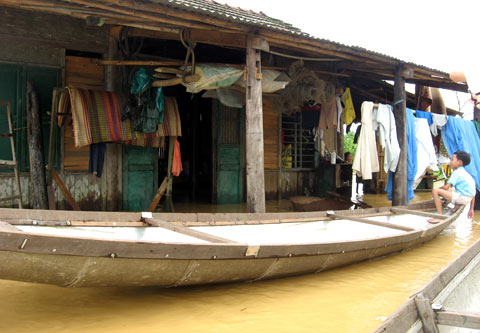Southeast Asia is considered the 'typhoon' of the world and Vietnam is one of the 10 countries in the world affected by natural disasters and climate change.
On August 25, the Asian Conference on Disaster Impact Assessment opened in Hue City with the participation of more than 60 leading experts from 20 countries around the world and the United Nations.
According to data at the conference, natural disasters in Asia accounted for nearly 40% of the world and the damage caused by natural disasters in this continent accounted for nearly 60% of the world. Southeast Asia is 'hurricane' and is one of the most vulnerable and vulnerable areas of climate change due to floods, storms, sea level rise, drought . In which, Vietnam is One of the 10 countries in the world is the most affected by natural disasters and climate change.

Floods submerged houses in Phu Thanh commune, Phu Vang district, Thua Thien - Hue in 2009.
Photo: Tran An
According to the representative of the World Meteorological Organization, the level of carbon dioxide accumulation and greenhouse effect substances has reached its highest level ever. The inevitable consequence of this situation is climate change, an increase in the frequency and intensity of natural disasters in the world. The most obvious manifestation is the continuous drought phenomenon in the two years 2009-2010 in Australia, Vietnam and Africa; the phenomenon of ice melting at the poles with the record of the tremendous size of the ice sheet separating in Alaska is 250km; most recently are floods and landslides in China and Pakistan.
According to Mr. Joshi - Professor of Social Anthropology - Chairman of Indian Medical Anthropology, Vietnam is fortunate to have yet to happen earthquakes, but the situation of storms and floods is complicated. Therefore, Vietnam needs to have long-term strategies for urban planning, irrigation planning, land fund planning .
A study presented at the conference showed that in India, when an earthquake struck, houses built with modern technology collapsed more than houses built according to traditional techniques. That is why countries need to share indigenous knowledge for each other to cope with natural disasters.
 Vietnam 5th Asian champion on fuel-efficient vehicles
Vietnam 5th Asian champion on fuel-efficient vehicles We can read all NASA studies completely free of charge
We can read all NASA studies completely free of charge Singer and songwriter Bob Dylan won the 2016 Nobel Prize for Literature
Singer and songwriter Bob Dylan won the 2016 Nobel Prize for Literature Scientific revolution in Asia
Scientific revolution in Asia